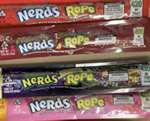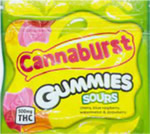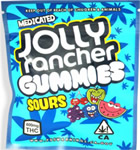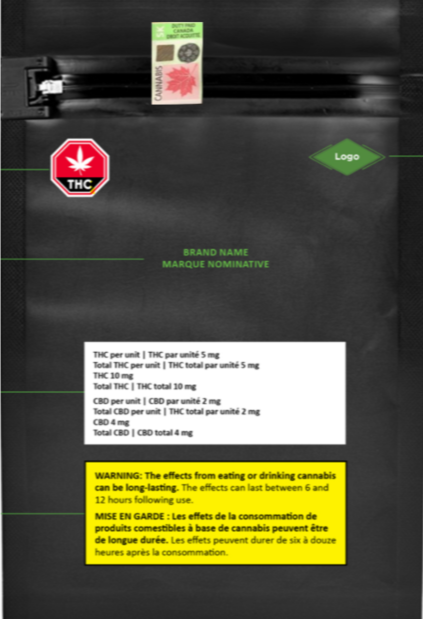Accidental ingestion of illegal “copycat” edible cannabis products causing serious harm to children
Summary
When purchasing cannabis, purchase only legal and regulated cannabis products in plain packaging with child-resistant features and only from provincially and territorially authorized retailers. Store all cannabis products securely and out of the reach and sight of children, teens, and pets.
Affected products
The implicated products are illegal cannabis edibles that can cause serious harm when consumed, especially by children or pets. Any products with flashy packaging, pictures, catchy names, strange THC symbols or that mimic popular name brands are illegal and unregulated, should not be consumed and should be reported to your local law enforcement.
Examples of illegal edible cannabis products that Health Canada is aware of include the following:
| Illegal "Copycat" Product | Photo |
|---|---|
| Stoneo packaged to look like Oreo Cookies, and offered in several flavours |
 |
| Cheetos products packaged to look like Cheetos, offered in several varieties |
  |
| Nerds Rope packaged to look like Nerds Rope |
 |
| Froot Loopz packaged to look like Froot Loops
|
 |
| (Medicated Sour) Skittles packaged to look like Skittles |
 |
| (Sours Medicated) Starburst Gummies or Cannaburst Gummies Sours packaged to look like Starburst |
  |
| Ruffles, Doritos, Fritos packaged to look like Ruffles, Doritos and Fritos |
 |
| (Medicated) Jolly Rancher Gummies Sours packaged to look like Jolly Ranchers |
 |
| Stoney Patch packaged to look like Sour Patch Kids |
 |
| Airheads Xtremes packaged to look like Airheads |
 |
| (Herbivores Edibles) Twonkie packaged to look like Twinkies |
 |
| Fruit Gushers packaged to look like Fruit Gushers |
 |
|
MaryJanerds products including:
packaged to look like Maynard candy brands |
 |
|
HIGH-CHEW candy packaged to look like HI-CHEW candy |
  |
Related Health Canada Web content
Issue
Health Canada is reminding Canadians of the risk of serious harm if children accidentally consume edible cannabis. Health Canada is aware of children being hospitalized, particularly after consuming products that are illegal and unregulated.
Hospitals have seen an increase in visits to the emergency room and poison centres have seen an increase in calls. Poisonings can be life-threatening, sometimes resulting in coma, being put on a ventilator, or in rare cases, even death. While there have been no fatal cases reported in Canada to date, Health Canada is aware of international cases of paediatric cannabis poisoning leading to death.
Illegal edible cannabis products may be packaged to look like popular brands of candies, snacks or other food products that are typically sold at grocery stores, gas stations and corner stores. These products are illegal and prohibited under the Cannabis Act and itsRegulations.
Legal cannabis products are packaged in plain packaging, which helps reduce their appeal to youth and avoids them being confused with other products. Legal cannabis product packaging also comes with a Health Warning Message in a yellow box, the red cannabis symbol, an excise stamp, and is packaged in child-resistant packaging to prevent children from being able to open the product.
Examples of copycat illegal edible cannabis can include cereal and snack foods such as chips, cheese puffs, cookies, chocolate bars, and a variety of popular candies in colorful packaging. These products can contain high amounts of THC, which increases the risk of experiencing adverse effects or poisoning. Parents and children may not be able to recognize these products as anything other than their favourite brands of candy or snack foods.
What you should do
When purchasing cannabis, purchase only legal and regulated cannabis products in plain packaging with child-resistant features and only from provincially and territorially authorized retailers. Store all cannabis products securely and out of the reach and sight of children, teens, and pets.
Who is affected
Children and young persons are at risk of serious harm if they accidentally ingest cannabis.
Signs that a child has ingested cannabis can include:
- chest pain
- rapid heartbeat
- nausea
- vomiting
- psychotic episode
- slowed and ineffective breathing (respiratory depression)
- severe anxiety
- panic attack
- agitation
- confusion
- slurred speech
- unsteadiness on feet
- drowsiness/lethargy
- muscle weakness
- loss of consciousness
What consumers should do
If you possess cannabis, store it securely away from children, teens, and pets. Be careful with edible cannabis, which can be mistaken for regular food or drink, especially when it is removed from its original packaging. Consider storing cannabis products in a locked drawer or box, and separate from regular food or drinks. More information on safe cannabis storage can be found here.
If someone is having a serious medical emergency related to a cannabis product, call 911, or contact your regional poison center. This fact sheet also has information about cannabis poisoning that can help guide you. If you have questions or concerns about cannabis and your health, consult your health care practitioner.
Illegal versus legal retailers
The Cannabis Act and its Regulations create a strict legal framework to regulate and restrict access to cannabis in Canada. To protect the health and safety of Canadians, the Act imposes a number of controls on the production of cannabis, as well as its movement and distribution. These controls are designed to ensure that legally produced cannabis meets strict quality control standards. Illegal cannabis products do not have these strict quality control standards.
Always purchase cannabis products from provincially and territorially authorized online retailers or authorized retail stores. Each province and territory has a website link that includes a list of authorized, legal cannabis retailers. Make sure you only purchase edible cannabis and other cannabis products from these retailers. Consult the Health Canada website or the provincial and territorial lists below regularly as they are updated frequently.
- British Columbia
- Alberta
- Saskatchewan
- Manitoba
- Ontario
- Quebec
- New Brunswick
- Nova Scotia
- Prince Edward Island
- Newfoundland and Labrador
- Nunavut
- Northwest Territories
- Yukon
If you are considering buying cannabis products online, please consult the webpage Buying Cannabis Online – What You Need to Know.
If you require cannabis for medical purposes, the webpage Licensed cultivators, processors and sellers of cannabis under the Cannabis Act, has a full list of authorized licence holders.
Recognizing illegal versus legal cannabis products
The packaging and labelling requirements of legal cannabis products are meant to minimize harms from cannabis use. Requirements include plain packaging and labelling, displaying a health warning message, and providing information about how much THC and CBD are in the cannabis product.
Canadians can learn more about how to recognize a legal cannabis product to keep themselves safe. Follow these tips to help determine if the product you are going to purchase or have purchased is legal or illegal:
- Cannabis products sold by authorized retailers containing more than 0.3% THC are required to have an excise stamp at the point of sale. If a packaged cannabis product does not have an excise stamp at the time of purchase, it is an illegal product. Find your provincial or territorial excise stamp on the webpage Cannabis in the provinces and territories.
- Legal edible cannabis products can only contain up to 10 milligrams of THC per package. If a retailer is selling edible cannabis products that contain more than 10 milligrams of THC per package, then the retailer is selling illegal cannabis that is unregulated.
- All legal cannabis products have this symbol on them:

- All legal cannabis products will have a yellow box with a health warning message.
- Legal cannabis products must have plain packaging. This is to prevent the products from appealing to youth. Illegal products are often packaged with bright, bold colours and are made to look like familiar brands of products that are not cannabis products.
- Below is an example of a legal edible cannabis product compared to an illegal one:
- The legal edible cannabis product clearly has plain, child-resistant packaging, the warning message in yellow, the provincial or territorial excise stamp, and the THC symbol;
- The illegal edible cannabis product, which has flashy packaging, is easily opened by children who can use the tear notches at the top, does not have the warning symbol, nor does it state the amount of THC in the product.
Legal vs Illegal Product Legal Product Illegal Product 
(Image 2: example of legal & regulated cannabis edible product)
(Image 3: example of illicit cannabis edible cannabis product)
Reporting issues with cannabis products
If you are concerned or have a complaint about a possible illegal cannabis product or suspected illegal activity (for example, suspecting that someone may be growing or selling cannabis illegally), you should contact your local law enforcement.
Health Canada also welcomes cannabis-related reports from consumers, health professionals, industry and the general public about cannabis products. For concerns and complaints that might represent a possible violation of the federal cannabis laws or regulations, individuals may contact Health Canada through the Cannabis Reporting Form.
Examples of concerns with cannabis products could include:
- product labelling (for example, missing mandatory health warning message)
- product packaging (for example, shape that may be appealing to youth)
- promotions (for example, cannabis radio commercial)
- product quality (for example, mould, mite, powdery mildew, pesticides)
- cannabis production site (for example, security concerns at a licensed site)
- cannabis accessories (for example, injury caused by malfunction)
All reports received through the Cannabis Reporting Form will be reviewed to determine if they are within Health Canada's responsibilities and if so, they will be assessed and prioritized for action according to public health and safety risk. Actions taken will be consistent with Health Canada's Compliance and Enforcement Policy for the Cannabis Act. Where appropriate, reports may also be forwarded to law enforcement organizations.
What Health Canada is doing
The Cannabis Act and its Regulations create a strict legal framework for controlling the production, distribution, sale, and possession of cannabis across Canada. The Act and its Regulations allow adult Canadians to legally access quality controlled cannabis, while restricting access to children and youth.
Illegal products do not follow the strict legal framework for cannabis and they can cause risks to public health and safety. Health Canada refers all known cases of illegal edible products to law enforcement for follow-up and works closely with Public Safety Canada, law enforcement and other stakeholders to disrupt the illegal cannabis market and to protect Canadians from unregulated, illegal cannabis.
Health Canada also works with law enforcement agencies, the Canada Border Services Agency (CBSA) and companies whose trademarked brands are used on illegal cannabis edibles to help remove these products from the market.
Public education is also fundamental to protecting public health and safety. By disseminating clear, consistent and evidence-based information on the health and safety facts about cannabis, Health Canada enables Canadians to make informed choices and better understand the potential harms and risks of cannabis use. For more cannabis education resources, please visit Health Canada's website.
Additional information
Details
Media and public enquiries
Media Enquiries
Health Canada
(613) 957-2983
media@hc-sc.gc.ca
Public Enquiries
(613) 957-2991
1-866 225-0709
Get notified
Receive notifications for new and updated recalls and alerts by category.
















